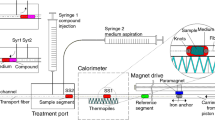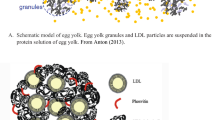Abstract
The effect of different dietary fats on peritoneal macrophage plasma membrane fluidity, intracellular cyclic AMP (cAMP) production, GTP hydrolysis and TNF binding and TNF-induced IL1 and IL6 production was investigated. After a four week period, fluidity, as determined by both fluorescence recovery after photobleaching (FRAP) and anisotropy was lowest and highest in animals fed corn and fish oil respectively. After eight weeks feeding, lateral membrane movements were decreased substantially in fish, olive and coconut oil fed dietary groups, whereas an increase in the corn oil fed group was observed, no effect was observed in macrophages from the butter fed group. However, an increase in the packing was observed in macrophages from all dietary groups except in the olive oil fed group. GTPase values for the coconut oil and butter groups were higher than in any other dietary group. After receiving the diet for 8 weeks these differences between the groups were no longer apparent. Exposure of macrophages to TNF had no effect on the rate of GTP hydrolysis. A major enhancement of cAMP production became apparent between weeks 4 and 8 of dietary treatment. After 4 weeks on the diet, values were significantly higher from cells of animals fed corn and olive oils than from animals fed fish oil. After 8 weeks, while there was a general enhancement of production, further differences became apparent. Feeding corn and coconut oils resulted in the highest values and olive oil and chow in the lowest. It is proposed that fats rich in n-3 fatty acids (fish oils) alter membrane fluidity, decrease TNF binding affinity, GTPase activity and cAMP production which appears not to modify cytokine production after short term dietary supplementation. However, after long term feeding it appears that increases in the sensitivity of the TNF receptors plays a major role in modifying cytokine production. (Mol Cell Biochem 166: 135-143, 1997)
Similar content being viewed by others
References
Male D, Roitt I, Rook I, et al.: In: I Ruitt, O Brostoff and D Male (eds). Immunology. Churchill Livingstone, Edinburgh, London and Melbourne, 1989
Grimble RF: Malnutrition and the immune response: Impact of nutrients on cytokine biology in infection. Trans Roy Soc Trop Med Hyg 88: 615–619, 1994
Kremer JM, Robinson DR: Studies of dietary supplementation with n-3 fatty acids in patients with rheumatoid arthritis. World Rev Nutr Diet 66: 367–382, 1991
Kremer JM, Jubiz W, Michalek A, et al.: Fish-oil fatty acid supplementation in active rheumatoid arthritis: a double-blinded, placebo-controlled, cross-over study. Ann Int Med 106: 497–502, 1987
Bittiner SB, Tucker WFG, Cartwright I, et al.: A double-blind, randomised, placebo-controlled trial of fish oil in psoriasis. Lancet 378–380, 1988
Soloman P, Kornbluth AA, Janowitz HD: Treatment of ulcerative colitis with fish oil, a n-3 fatty acid: an open trial. J Clin Gastroenterol 12: 157–161, 1990
McCall TB, Oleary D, Bloomfield J, et al.: Therapeutic potential of fish oil in the treatment of ulcerative colitis. Alimentary Pharmacol Ther 3: 415–424, 1989
Endres S, Globani R, Kelley VE, et al.: The effects of dietary supplementation with n-3 polyunsaturated fatty acids on the synthesis of interleukin-1 and tumour necrosis factor by mononuclear cells. N Engl J Med 320: 266–271, 1989
Murphy MG: Dietary fatty acids and membrane protein function. J Nutr Biochem 1: 68–79, 1990
Brenner RR: Effect of unsaturated acids on membrane structure and enzyme kinetics. Progr Lipid Res 23: 69–96, 1984
Stubbs CD, Smith AD: The modification of mammalian membrane polyunsaturated fatty acid composition in relation to membrane fluidity and function. Biochim Biophys Acta 119: 89–137, 1984
Stubbs CD, Tsang WM, Belin J, Smith AD, et al.: Incubation of exogenous fatty acids with lymphocytes. Changes in fatty acid composition and effects on the rutational relaxation time of 1,6-diphenyl-1,3,5-hexatriene. Biochemistry 19: 2756–2762, 1980
Pfizenmaier K, Himmler A, Schutze S, et al.: TNF receptors and TNF signal transduction. In: B Beutler (ed.) Tumour necrosis factors: the molecules and their emerging role in medicine., Raven Press, New York, 1992, pp 439–472
Smith SB, Seigal JR and White HD: Cyclic AMP-dependent protein kinase: cyclic nucleotide binding, structural changes and release of the catalytic subunit. Proc Natl Acad Sci USA 78: 1591–1595, 1981
Ross EM, Gilman AG: Biochemical properties of hormone-sensitive adenylate cyclase. Annu Rev Biochem 49: 533–564, 1990
Kunkel SL, Remick DG, Spengler M, et al.: Modulation of macrophage derived interleukin-1 and tumour necrosis factor-α by prostaglandin E2. Adv Prost Leuk and Throm Res 17: 155–158, 1987
Zitnik RJ, Zheng T, Elias JA: cAMP inhibition of IL-1 induced IL-6 production by human lung fibroblasts. Am J Physiol 264: L252-L260, 1993
Striter RM, Remick DG, Ward PA, et al.: Cellular and molecular regulation of tumour necrosis factor α production by pentoxifylline. Biochim Biophys Res Commun 155: 1230–1236, 1988
McCance and Widdowson: In: P. Southgate and D Russell (eds). The Composition of Foods. First supplement. London. HMSO, 1978
Tappia PS, Grimble RF: Complex modulation of cytokine induction by endotoxin and tumour necrosis factor from peritoneal macrophages of rats by diets containing fats of different saturated, monounsaturated and polyunsaturated fatty acid composition. Clin Sci 87: 173–178, 1994
Kubry JG, Duportail G, Bronner C, et al.: Plasma membrane fluidity measurements on whole living cells by fluoresence anisotropy of trimethylammoniumdiphenylhexatriene. Biochim Biophys Acta 845: 60–67, 1985
Scatchard G: The attraction of proteins for small molecules and ions. Ann NY Acad Sci 51: 660–672, 1949
Renz H, Gong J-H, Schmidt A, et al.: Release of tumour necrosis factor-α from macrophages. J Immunol 141: 2388–2393, 1988
Imamura K, Sherman ML, Spriggs D, et al.: Effect of tumour necrosis factor on GTP binding and GTPasc activity in HL-60 and L929. J Biol Chem 263: 10247–10253, 1988
Larsen NE, Eneloe RI, Simons ER, et al.: Effect of bacterial endotoxin on the transmembrane electrical potential and plasma membrane fluidity of human monocytes. Biochim Biophys Acta 815: 1–8, 1985
Vigh L, Los DA, Horvath J, et al.: The primary signal in the biological perception of temperature: Pd-catalysed hydrogenation of membrane lipids stimulated the expression of the des A gene in Synechocystis PCC6803. Proc Nat Acad Sci 90: 9090–9094, 1993
Calder PC, Newsholme EA: Polyunsaturated fatty acids suppress human peripheral blood lymphocyte proliferation and interleukin-2 production Clin Sci 82: 695–700, 1992
Calder PC, Yaqoob P, Harvey DJ, et al.: Incorporation of fatty acids by concanavalin A stimulated lymphocytes and the effect on fatty acid composition and membrane fluidity. Biochem J 300: 509–518, 1994
Tappia PS, Grimble RF: The relationship between altered membrane composition, eicosanoids and TNF-induced IL1 and IL6 production in macrophages of rats fed fats of different unsaturated fatty acid composition. Mol Cell Biochem In Press.
Skuladottir GV, Schioth HB, Gudbjarnason S: Polyunsaturated fatty acids in heart muscle and α1-adrenoreceptor binding properties. Biochim Biophys Acta 1178: 49–54, 1993
Grynberg A, Fournier A, Sergiel JP, et al.: Effect of docosahexaenoic acid and eicosapentaenoic acid in the phospholipids of rat heart muscle cells on adrenoreceptor responsiveness and mechanism. J Mol Cell Cardiol 27: 2507–2520, 1995
Arnold RS, Newton AC: Diacylglycerol directly stimulates the insulin receptor tyrosine kinase. FEBS Lett 380: 58–62, 1996
Author information
Authors and Affiliations
Rights and permissions
About this article
Cite this article
Tappia, P.S., Ladha, S., Clark, D.C. et al. The influence of membrane fluidity, TNF receptor binding, cAMP production and GTPase activity on macrophage cytokine production in rats fed a variety of fat diets. Mol Cell Biochem 166, 135–143 (1997). https://doi.org/10.1023/A:1006875010120
Issue Date:
DOI: https://doi.org/10.1023/A:1006875010120




